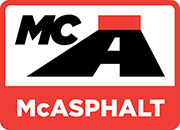Base Stabilization
The purpose of base stabilization is to increase the bearing capacity (or strength) of the roadbed materials. Adding an emulsified asphalt, and possibly other fillers, increases the road’s firmness and resistance to weather, while reducing movement or rutting in the base layer. Mix design work performed in the lab seeks to maximize the strength of the base materials and minimize the effects of moisture and freeze/thaw cycles.
Design Criteria
In order to design a mix to satisfy the objectives of the project the existing pavement must be investigated for structural adequacy, thickness, slope and cross-fall as well as the visual appearance. Based on these criteria a proper design can be developed. In most instances the design procedure developed by Wirtgen is the accepted method of design. This design procedure is well laid out in the Wirtgen Cold Recycling Technology Manual.
The following is a guide to the design procedure:
- Obtain representative samples of the base, sub-base and sub-grade materials from field
- Determine gradation and physical properties of various granular materials
- Select amount and type of additional aggregate if required
- Select type and grade of recycling additive
- Estimate recycling, additive demand
- Determine pre-mix moisture content for coating
- Test trial mixtures, initial curing properties, final curing properties, and moisture sensitivity
- Establish job mix formula
- Make adjustments in field
Materials – Recycling Additives
Asphalt Emulsions:
A number of different types and grades of asphalt emulsions can be used in Base Stabilization. The proper emulsion to be used is based on a number of factors; environmental conditions (temperature and humidity), time of year, and the existing road conditions. All these conditions affect the emulsion to be used. Typically the most common emulsions used are CSS-1, CMS-2 (polymer versions included) as well as proprietary products. Compatibility between the emulsion and the reclaimed material is critical to make the system work.
Expanded (Foam) Asphalt:
The asphalt cement typically used in base stabilization is PG58-28. Softer grades can be used if the specification requirements for tensile strength can be met. To create the foam 2-3% water is injected into the hot (150-170°C) asphalt.
Blended Material:
The blended material is created by the pulverization of the underlying granular materials into a homogeneous mixture. Virgin aggregate, RAP material, or crushed concrete can be added to improve overall strength. Typically the maximum particle size is 37 mm. The pulverizing machine can control the gradation of the material through speed, milling head direction as well as the added granulars.
Modifiers:
There are different modifiers that can be used in the FDR process. Besides the asphalt emulsion or Expanded (Foam) Asphalt, virgin aggregate may be added to improve gradation, stability or cross slope. Portland cement or lime in dry or slurry form as well as Type C Fly ash can be used to improve early strength, cohesion and resistance to moisture damage.
Aggregate:
Aggregates used to improve the gradation or give extra strength can be virgin crusher run, recycled crushed concrete or recycled asphalt pavement (RAP). The virgin aggregate can also be coarse aggregate if the gradation needs to be corrected due to the fine nature of the pulverized material.
Performance Guidelines
In order to construct a proper well designed base stabilized mix the following guidelines should be followed:
- Ensure the existing structure is adequate to support expected traffic
- Evaluate existing structure for distresses and make sure repairs completed prior to construction
- Ensure that the base stabilization process is the proper process to be used
- Determine if a corrective aggregate or other modifiers such as cement are needed
- Ensure a proper mix design is done. Use mix design as a guide only
- Field adjustments may have to be made to water content or recycling additive to achieve good coating and workability
- Proper equipment needed (reclaimer, grader, water truck, compactors)
- Use of vibratory footpad, pneumatic ,vibratory rollers and static steel rollers used
- If modifier used compaction begins as soon as mix is placed
- Breakdown rolling following by shaping and final compaction
- Rolling patterns should be established at start with use of nuclear gauge
- Curing of finished mat is required before placement of wearing surface
- Curing can vary depending on environmental conditions and type of additive used. Typically 2 to 4 days for foam and 10-14 days for emulsions
- A light fog seal may be needed to prevent surface ravelling
- Typically a HMA wearing surface is placed over the stabilized base. Mix type governed by structural requirements
